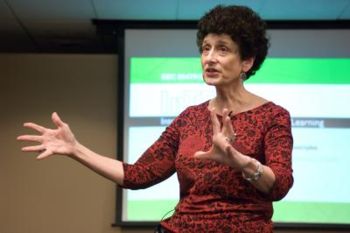Murray, Janet
From DigitalRhetoricCollaborative
Janet Murray is currently a professor at the Georgia Institute of Technology’s School of Literature, Media, and Communication. Murray graduated from the Bronx High School of Science and SUNY Birmingham. She was trained by IBM as a systems programer, and then earned her Ph.D in English Literature from Harvard University. [1]Prior to coming to Georgia Tech in 1999, Murray was a Senior Research Scientist in the Center for Educational Computing Initiatives at MIT. There, starting in 1971, she taught in the humanities department and led advanced interactive design projects. Murray is widely known as an early developer of humanities computing applications, a theorist of digital media, and an advocate for new educational programs in digital media. Her most notable works are Hamlet on the Holodeck: The Future of Narrative in Cyberspace, and Inventing the Medium.
Contents |
[edit] Career and Contributions
In the early eighties while Murray was teaching in the humanities department at MIT, her students showed her ELIZA and Zork. They caused Murray to see storytelling potential in new digital mediums. Those ideas inspired Murray to write Hamlet on the Holodeck: The Future of Narrative in Cyberspace . Hamlet on the Holodeck is a guide through the mediums of "broadband art, information, and entertainment environments."[1] In Hamlet on the Holodeck, Murraydiscusses the unique properties and pleasures of digital environments and connects them with the traditional satisfactions of narrative. She analyzes the dramatic satisfaction of participatory stories and considers what would be necessary to move interactive fiction from the formats of childish games and confusing labyrinths into a mature and compelling art form. Through a blend of imagination and techno-wizardry, Murray provides both readers and writers with a guide to the storytelling of the future.[2]In Inventing the Medium, Murray provides provides "a unified vocabulary and a common methodology for the design of digital objects and environments."[3] Murray also says that
Innovative interaction designers should think of all objects made with bits--whether games or Web pages, robots or the latest killer apps--as belonging to a single new medium: the digital medium. Designers can speed the process of useful and lasting innovation by focusing on the collective cultural task of inventing this new medium. Exploring strategies for maximizing the expressive power of digital artifacts, Murray identifies and examines four representational affordances of digital environments that provide the core palette for designers across applications: computational procedures, user participation, navigable space, and encyclopedic capacity.[3]
One of the most talked about subjects in Inventing the Medium is Murray's concept of the four affordances. Murray believes that "Everything made up of electronic bits is potentially: procedural (composed of executable rules), participatory (inviting human action and manipulation of the represented world), encyclopedic (containing very high capacity of information in multiple media formats), spatial (navigable as an information repository and/or a virtual place)."[4] The ideas behind the four affordances have helped many designers and users of digital and new media successfully navigate the rapidly evolving fields. Inventing the Medium is frequently used as a learning supplement in classrooms, and has been the subject of much debate and controversy. But it was praised by Harry Jenkins, with him saying it was an "epic accomplishment, one which we will all be mining for years to come."[1]
Murray also guest wrote for the textbook the New Media Reader, which is edited by Noah Wardrip-Frume and Nick Montfort. Like Hamlet on the Holodeck and Inventing the Medium, the New Media Reader is published through The MIT Press. The New Media Reader is a collection of essays from multiple authors. The textbook aims to present ideas that may have escaped the notice of the general public.[5] While Murray was serving as Director of the Graduate Program in Digital Media at Georgia Tech from 2000 to 2010, she "led curriculum and laboratory development for the MS degree, and the establishment of one of the world's first PhD programs in the field."[1]
[edit] Awards and Accomplishments
- Emerita trustee of the American Film Institute (active 2000-2009).[1]
- Emerita trustee of the board of directors for the George Foster Peabody Award (active 2006-20013).[1]
- Founded the eTV Lab at Georgia Tech.[6]
- In 2010, Prospect Magazine named her one of the "Top Ten Brains for the Digital Future".[1]
- Has had projects funded by IBM, Apple Computer,Intel Corporation, Motorola Research, Alcatel-Lucent, Cisco/Scientific Atlanta, the Annenberg-CPB Project, the Andrew W. Mellon Foundation, the National Endowment for the Humanities, and the National Science Foundation.
[edit] Related Topics
[edit] References
- ↑ 1.0 1.1 1.2 1.3 1.4 1.5 1.6 http://lmc.gatech.edu/~murray/
- ↑ http://mitpress.mit.edu/books/hamlet-holodeck
- ↑ 3.0 3.1 http://mitpress.mit.edu/books/inventing-medium
- ↑ http://inventingthemedium.com/four-affordances/
- ↑ http://www.newmediareader.com
- ↑ http://etv.gatech.edu

